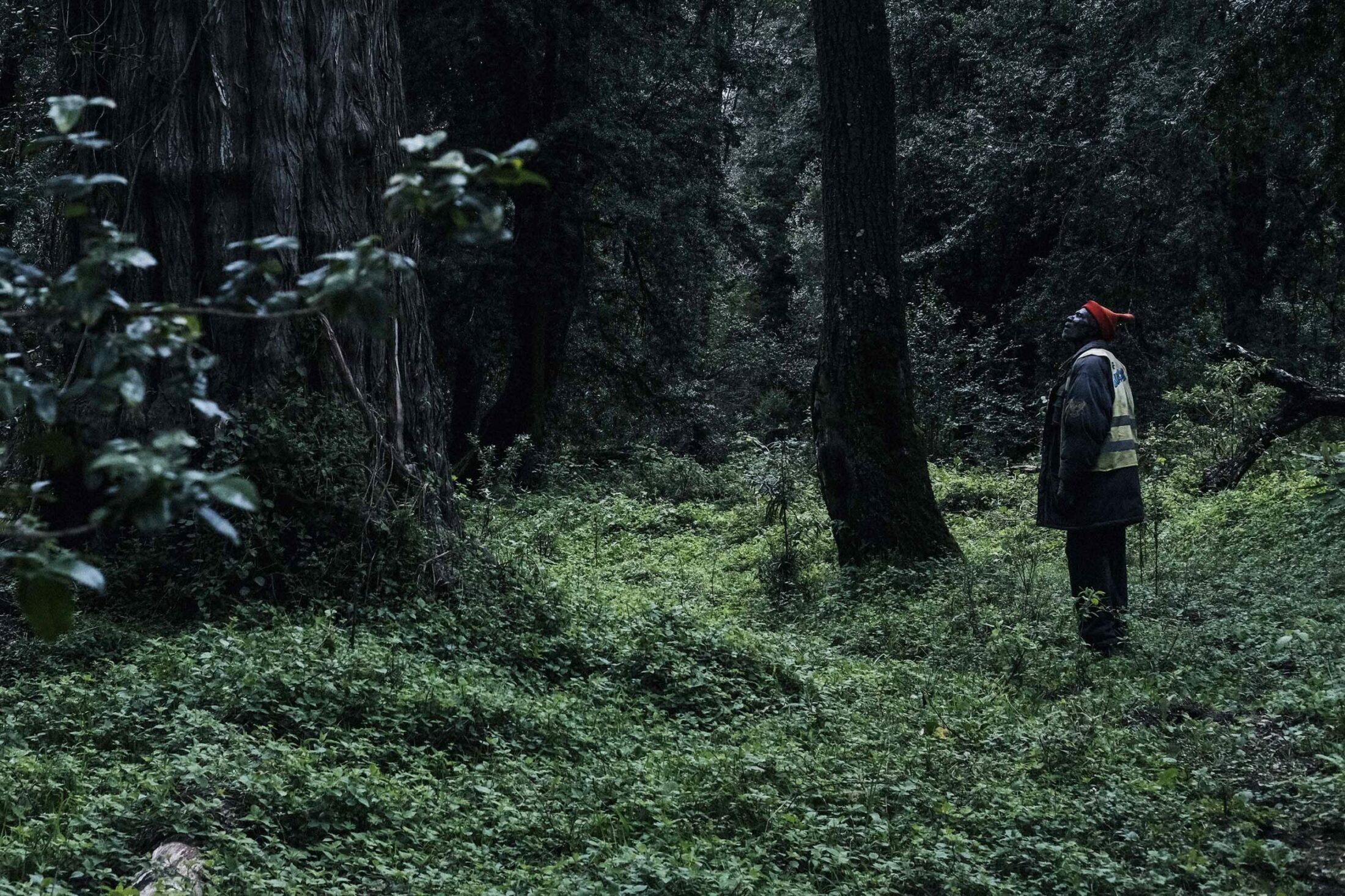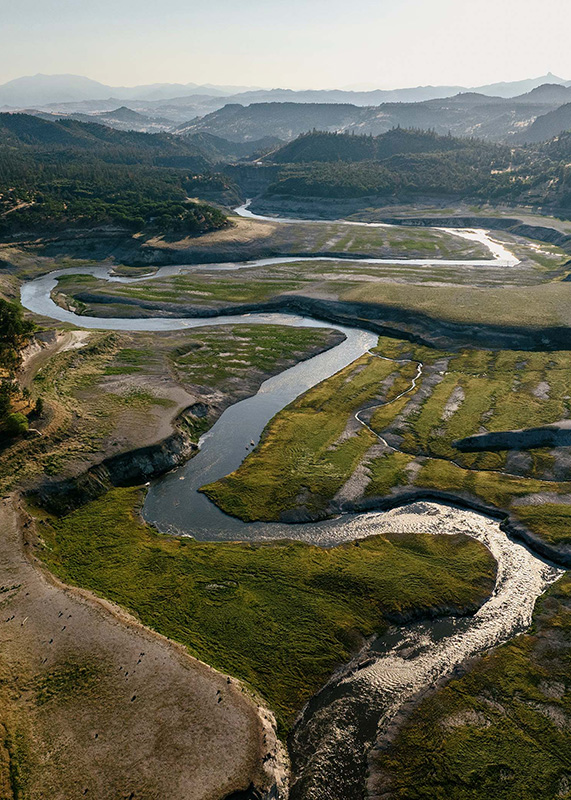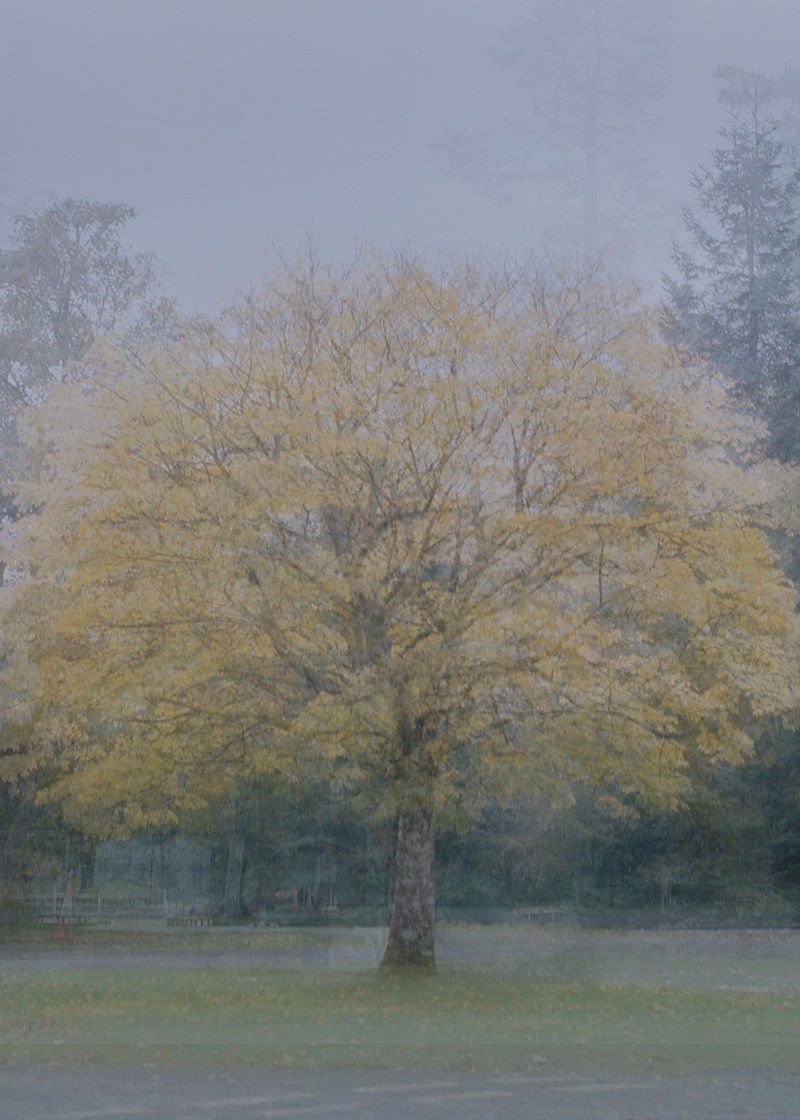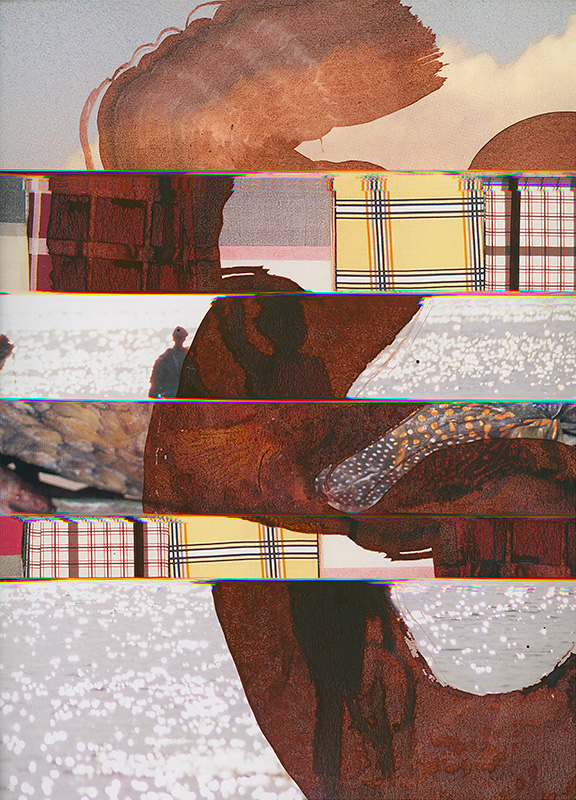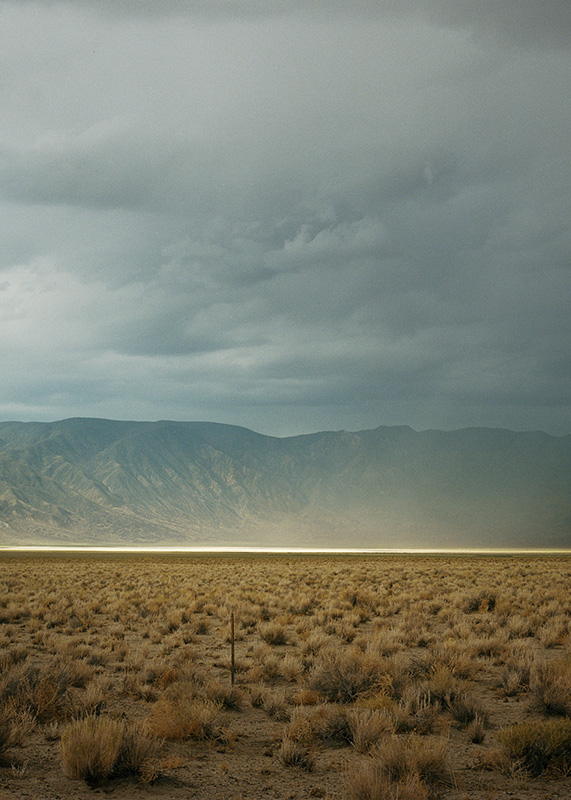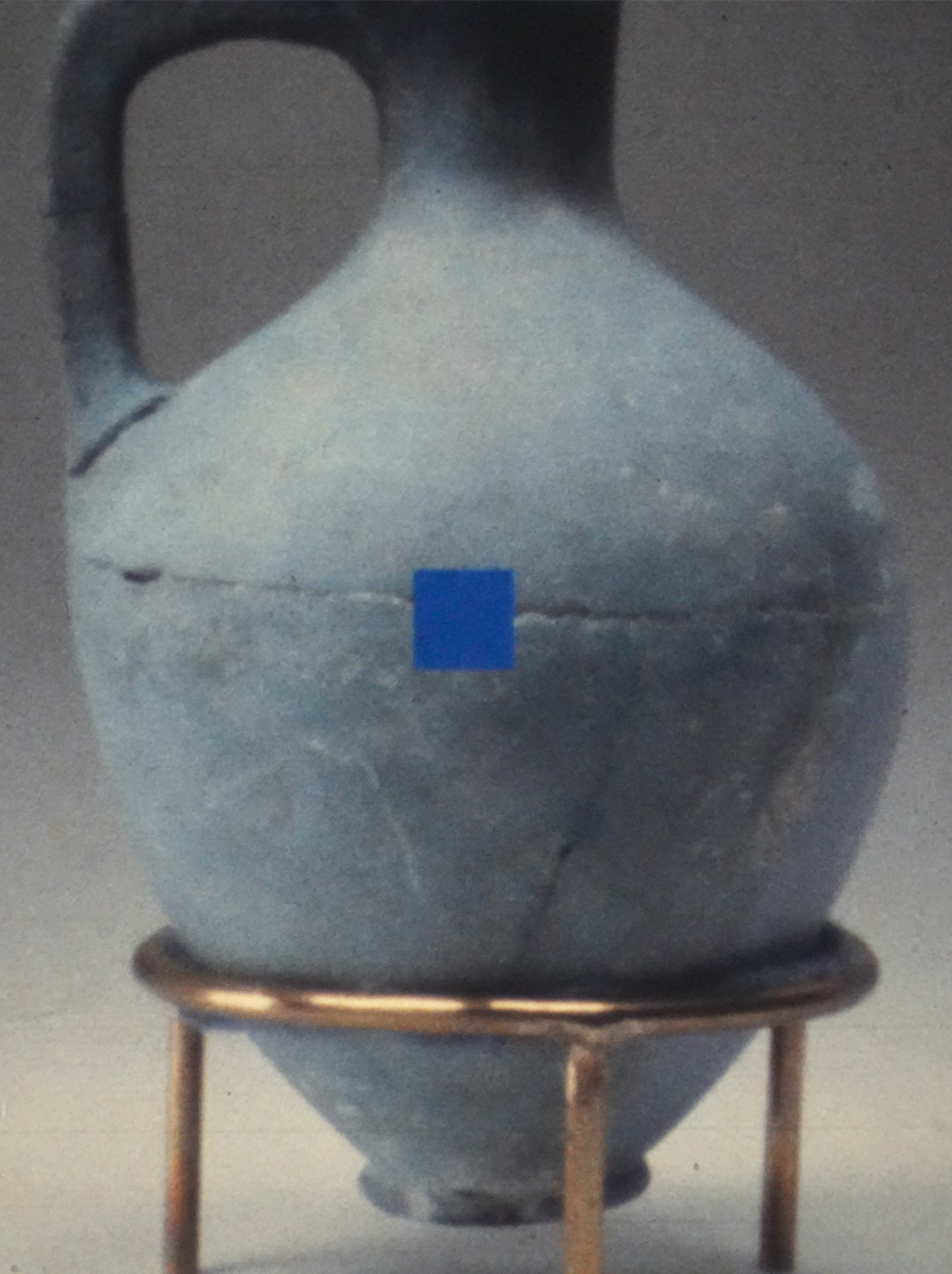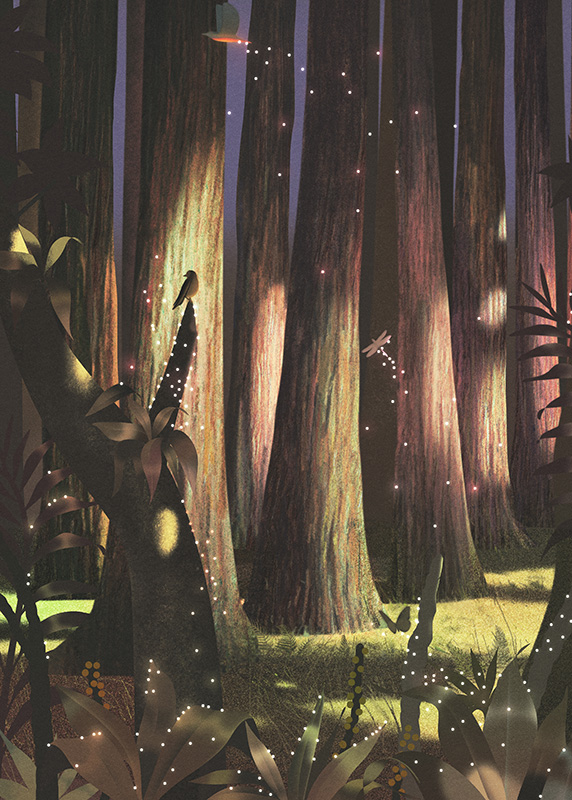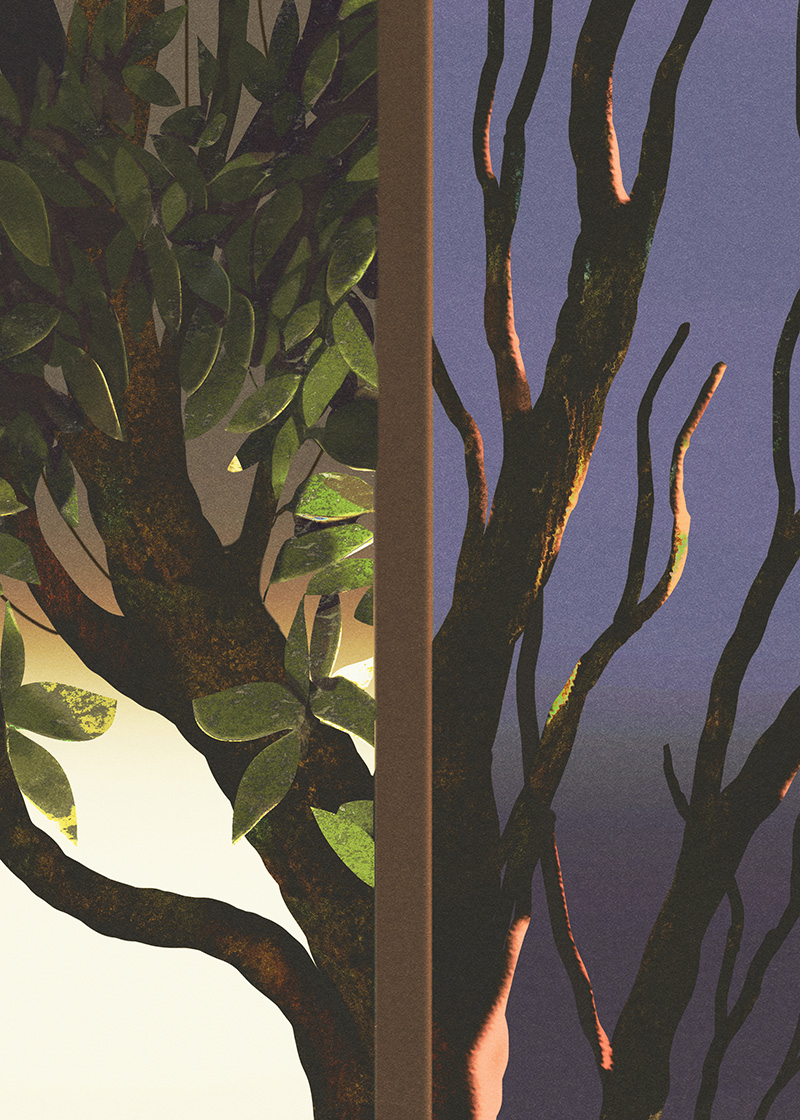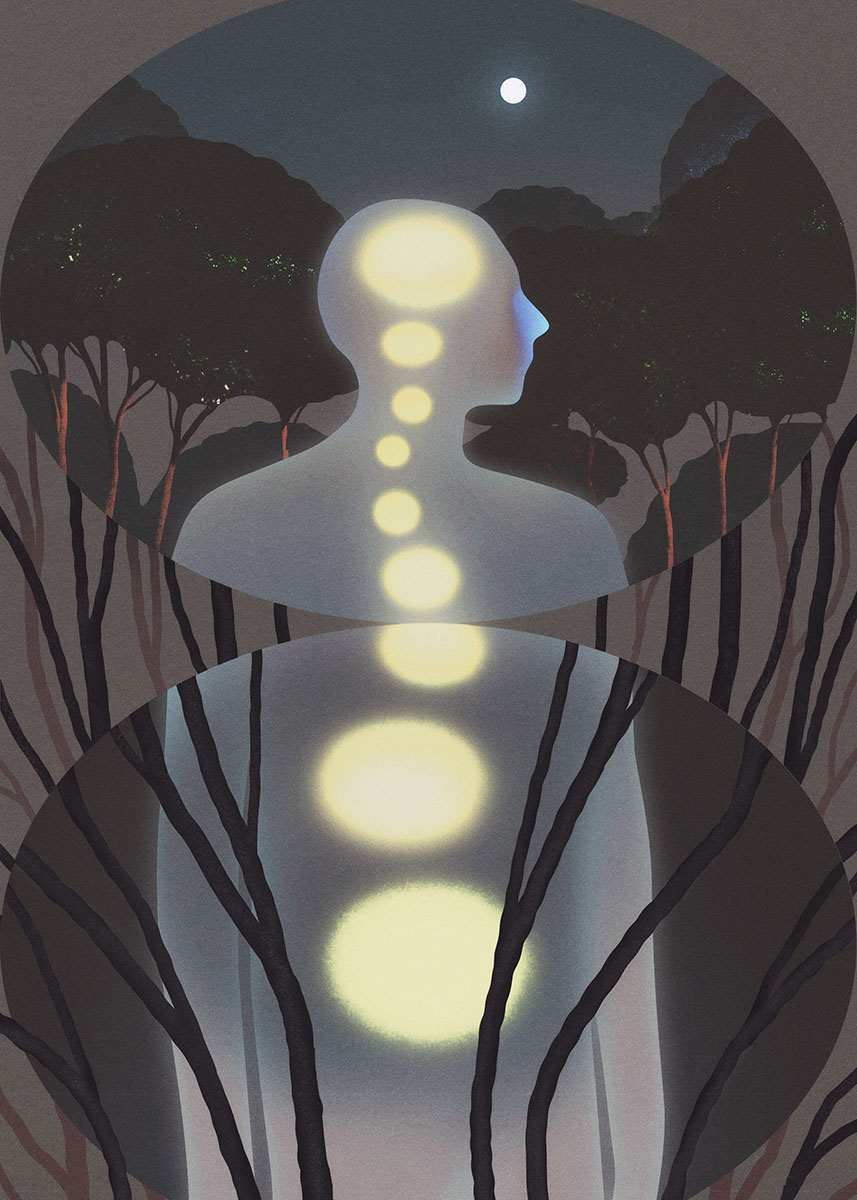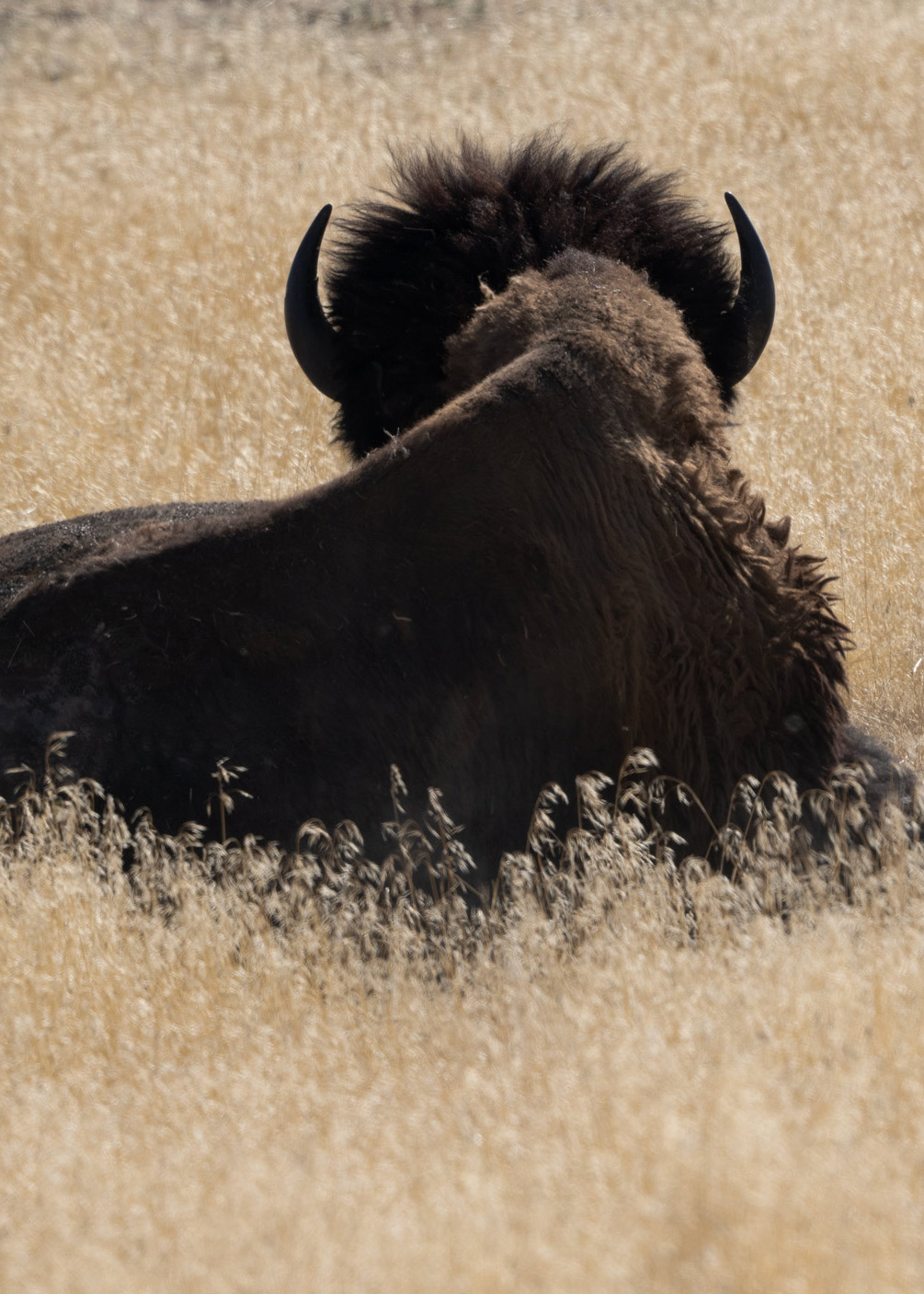
Tristan McConnell is a writer and foreign correspondent whose work has appeared in National Geographic, GQ, Harper’s, The New Yorker, Foreign Policy, The Times of London, The Economist, TIME, and many more. Tristan’s reporting has won awards from the Overseas Press Club of America, the Scripps Howard Foundation, the Society for Features Journalism, the Prix Bayeux for War Correspondents, and the Society of Environmental Journalists. His work has also been shortlisted for a National Magazine Award, as well as numerous Kurt Schork and One World Media awards. He is currently working on a book about the African Rift Valley.
Kabir Dhanji is a Kenyan-born photojournalist based in Nairobi, Kenya, who has worked primarily across Africa and Australia. His international assignments focus on conflict geographies and humanitarian crises across the continent of Africa. His work has appeared in The New York Times, Time, The Guardian, The Atlantic, The Times, Le Monde, The Wall Street Journal, The Australian, and The Washington Post, among others.
Tristan McConnell ventures into the shrinking mountain forests that surround Mount Kenya, home to medicinal plants, ancient trees, rivers, and rainfall. In the wake of the legacies of colonialism and rampant poverty that have stripped much of the country of its trees, he encounters Kenyan foragers, conservationists, and elders who are working to restore the forests and safeguard its value.
Korathimithla
1. Ugai kiama kiroiguana.
2. Thaithayai Ngai thaaai.
1. Ugai borori uroagirira, na ando maroingeha.
2. Thaithayai N gai thaaai,
1. Ugai ando na mahio marogia uhoro,
2. Thaithayai Ngai thaaai.
1. Ugai megonda irogia iro, na ithaka irokiria konora.
2. Thaithayai Ngai thaaai.
Asking for Blessing
1. Say ye, the elders may have wisdom and speak with one voice.
2. Praise ye Ngai. Peace be with us.
1. Say ye that the country may have tranquillity and the people may continue to increase.
2. Praise ye Ngai. Peace be with us.
1. Say ye that the people and the flocks and the herds may prosper and be free from illness.
2. Praise ye Ngai. Peace be with us.
1. Say ye the fields may bear much fruit and the land may continue to be fertile.
2. Praise ye Ngai. Peace be with us.
Twice a week Joseph Mbaya trudges purposefully into the forest a few miles south of his home in the lee of Mount Kenya to forage for roots, bark, sap, and leaves. His neighbors find this behavior a little odd, his esoteric knowledge of the trees and plants eccentric; most of them would choose Tylenol over his herbal concoctions of infused teas. It is Friday morning and warm beneath the forest’s patchy canopy, despite being at an elevation well over nine thousand feet. Mbaya sweats in his layers of fleeces, his shirt and coat, patched Carhartt trousers, and brown leather boots. Occasionally he pauses in the forest’s silence to smoke raw tobacco rolled in old newspaper.
Hiking the forest tracks with Mbaya is like walking the aisles of CVS with a taciturn pharmacist. He speaks quietly and rarely, but among the cedar and yellowwood, rosewood and water-berry, stinkwood and olive trees, the stubbly, hollow-cheeked sixty-four-year-old finds treatments for arthritis, prostate cancer, toothaches, ear infections, upset stomach, indigestion, and even pungent wind. “This is the one,” mutters Mbaya, stooping next to a pepper-bark tree. Carefully, he sweeps away a thick layer of moss, carves a narrow strip of outer bark with his machete, drops the piece into his shopping bag, and then rubs the tree’s wound with soil and moss to protect it against fungal attack. The bark will be boiled and the resulting decoction drunk as a treatment for intestinal worms or asthma. (Similarly prepared, the pepper-bark’s long, shiny leaves are good for impotence, Mbaya says, or just a tasty soup.)
We walk on, scrambling up the steep hillsides and dropping into the valleys of this forest pharmacopeia. Mbaya pauses at a red stinkwood tree, resting his hand on the rough, dark bark, which can be used as treatment for cancer and typhoid. A cat’s claw creeper has wound itself around the stinkwood’s thick trunk. Mbaya slices away a baton of tuber and squeezes it hard while blowing out the sap, which can be used to treat ear infections or rubbed on gums to ease toothaches.
Mbaya’s understanding of and communing with the forests flanking Mount Kenya’s craggy peaks is part of a traditional value system that knows trees are more than just timber or charcoal, that chopping them down has a cost outstripping any market price, that using forests need not destroy them, that protecting forests need not turn them into impregnable fortresses. The resurfacing of such dissipating knowledge offers the mountain forests more hope than any fence, and provides a pathway to a different way of thinking about a changing world and our entanglement with it.
Stretching from Mozambique to the Red Sea, the East African Rift is about the length of Interstate 95 and roughly twice as broad as the Grand Canyon. It is a dynamic landscape still changing, geology’s deep time condensed and telescoped to a more comprehensible, almost human, scale. The rift grows wider by about a quarter inch a year, unzipping Africa from north to south. Ten thousand millennia from now, the Horn of Africa will have drifted into the Indian Ocean and the Rift Valley will become the floor of a new sea.
This basin and range faulting of the lithosphere reassembled the region, creating the landscape where humanity first found its place in the world, and where we still live today. When Mbaya places his feet on the earth, it is that same earth—one of fragmentation, complexity, diversity, and change—that helped drive our evolution as problem-solving, social beings finding our way in a world with which we must coexist. Mbaya’s careful, contemplative movement through the forests whispers the knowledge that this land has always been our home.
Just how and when its changes have occurred is an unspooling mystery with some surprising answers. In the 1960s, fossilized skull fragments of a beaked whale, a deep-sea creature that still exists today, were found by paleontologists working close to Lake Turkana: an immense inland sea located in northern Kenya, four hundred miles from the ocean at an elevation of about twelve hundred feet. The fossil dates back seventeen million years—evidence that the land was closer to both sea level and the sea.
Sometime after that Miocene whale propelled itself upriver and was stranded, tectonic activity began transforming East Africa into a land hospitable to early humans. A magma plume shoved the entire region skywards, stretching Earth’s crust until it fractured and collapsed into immense blocks. The resulting sharp rift shoulders and deep, rain-shadowed graben basins ended the coast-to-coast forest carpeting of Africa, creating a novel topography and a new climate on the eastern edge of the continent. At the same time, the slow-motion collision of the Asian and Indian plates drove the Himalayas upwards, sucking Africa’s moisture into its immense convection currents and parching its new uplands. East Africa was left—quite literally—high and dry.
The ability to come down from the trees of fragmented forests and cross stretches of grasslands became competitively advantageous for our hominin forebears, yet it remained handy to get back up those trees in times of danger, and so the walking, climbing bipedal ape was born. Around 2.5 million years ago, we were neither unique nor alone. A shifting environment drove changes in the brain that separated our ancestors from the crowded evolutionary field, as East Africa’s new topographical complexity demanded greater cognitive power. Environmental fragmentation and climate change ensured the extinction of some and the success of others as lakes filled or dried up, volcanoes erupted, and earthquakes disrupted the landscape. But if this land has shaped us, we have also reshaped it.
The immense freestanding volcano of Mount Kenya was pushed out of the earth three million years ago at the tail end of the Pliocene, a manic epoch geologically speaking, during which East Africa roiled like a turbulent ocean. It has stood sentinel since, watching over our evolution.
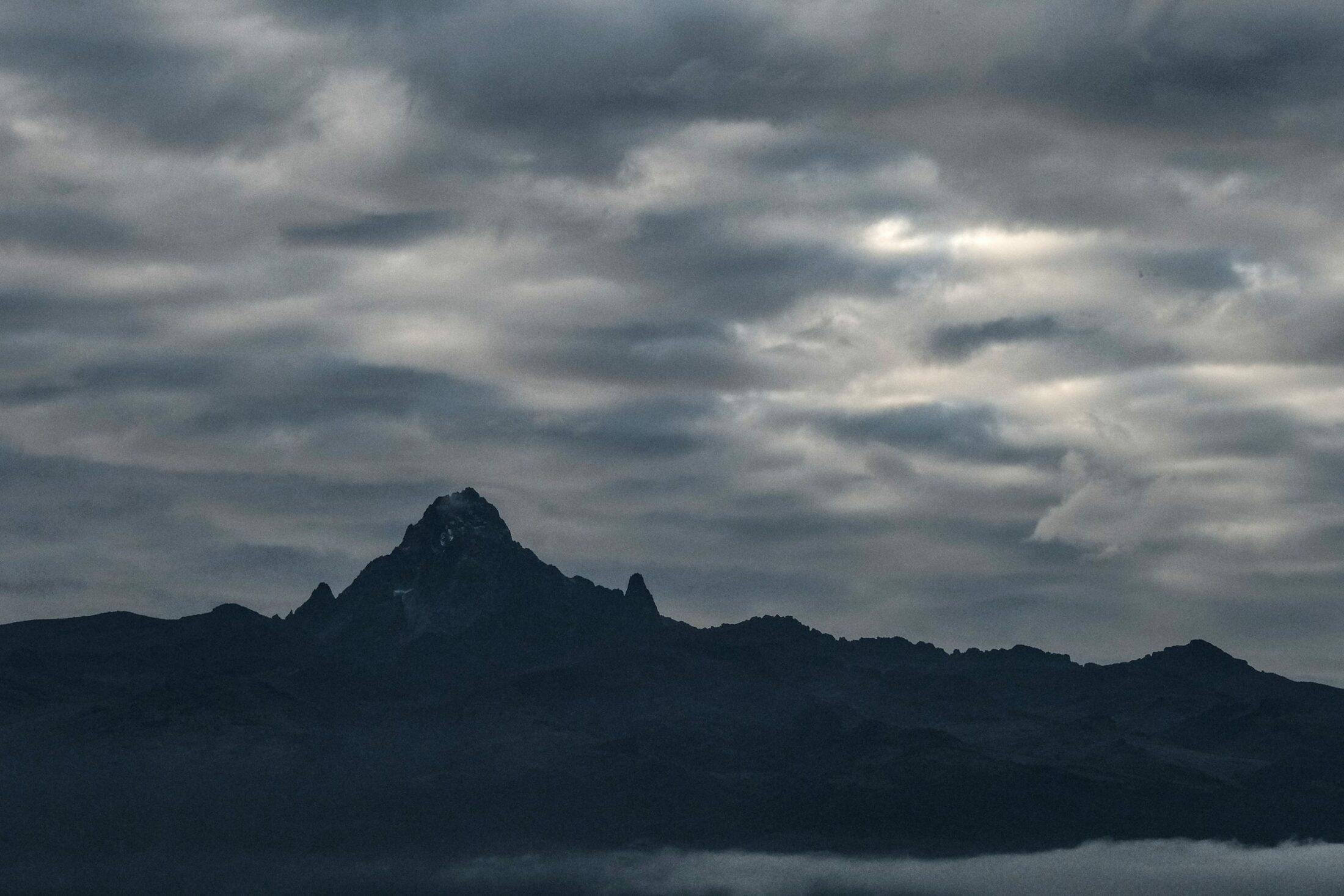
Overlooking the Rift Valley, Kirinyaga, commonly known as Mount Kenya, is home to the Kikuyu deity, Ngai
The mountain induces wonder—as many do—and it inspires meaning too. It was once known that Ngai (god) lived on the icy scarps of Kirinyaga, Mount Kenya’s original name in the Kikuyu language, which contains multiple meanings, like “mountain of mystery” and “mountain of brightness.” Below the shining, snow-capped peaks lived the people, farming and herding upon its slopes but rarely venturing into the sacred upper realms where sacrifices and petitions to Ngai would be made.
Mbaya’s visits to the high forests mark him out. While the swirling centrifugal forces of modernity have sucked so many others into a prison of quotidian constraints, Mbaya’s forest walks are a portal to a different, slower, and more meaningful world. Anyone can walk in the woods, but who truly knows them? As we strode, paused, scrambled, and sat, Mbaya painted the forest with his knowledge; trees and plants were illuminated by their names and made more vivid in their value and uses. To see the forest through his eyes— however fleetingly and partially—is to be granted a rare glimpse of an understanding that feels as inaccessible as Mount Kenya’s soaring peaks. But appreciation and preservation of the mountain and its forests is dwindling.
“These days we don’t have the same beliefs, the same respect. We used to believe god was on the mountain and that to cut the forest was a curse because you should not spoil the place where god lives,” Samson Thureinira says. Thureinira was born in 1923 and moves with a slow, deliberate gait in cracked and muddied gumboots, a threadbare V-neck sweater, and an outsized double-breasted jacket. I meet him at his wood-walled and tin-roofed bungalow facing Mount Kenya, up a eucalyptus-lined single track, where we sit in his proletarian garden: farming implements, chopped firewood, and a pile of bricks on the patchy grass. His face is exuberantly wrinkled like an olive tree’s bark, the white stubble on his head like moss.
Over his many years, he has gained too many grandchildren to count and lost every one of his friends, but his memory remains clear, Thureinira says, his voice gravelly but words firm, occasionally lending emphasis by didactic hand movements. “We used to know that we should not cut the forest, because there will be no rain.”
Long before scientists understood the astonishing alchemy by which trees draw carbon from the air and turn it into wood, or suck water from the soil and release it into the sky, communities living with forests knew their trees to be rainmakers—beliefs that safeguarded the forests, safeguarded the people who depended upon them. But beliefs are fragile things, as are those who embody them: Thureinira, still strong as a cedar’s trunk, slowing steadily as if moving on a timescale more akin to trees than humans as age stretches and remolds the experience of time; or Mbaya, younger and more vigorous, yet looked at askance for his strange, old ways.
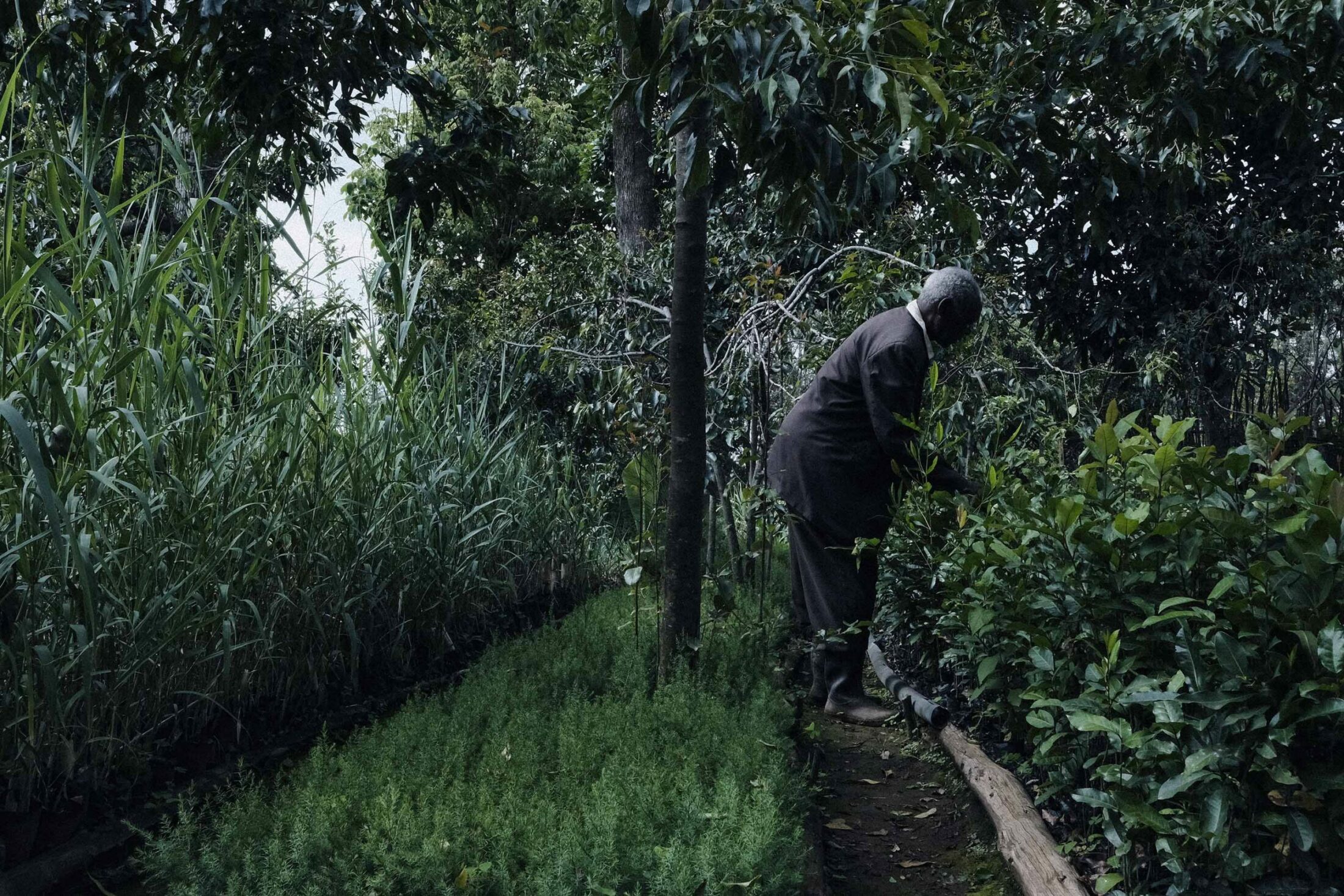
Samson Thureinira tends to saplings in the tree nursery he keeps behind his home, which faces Mount Kenya.
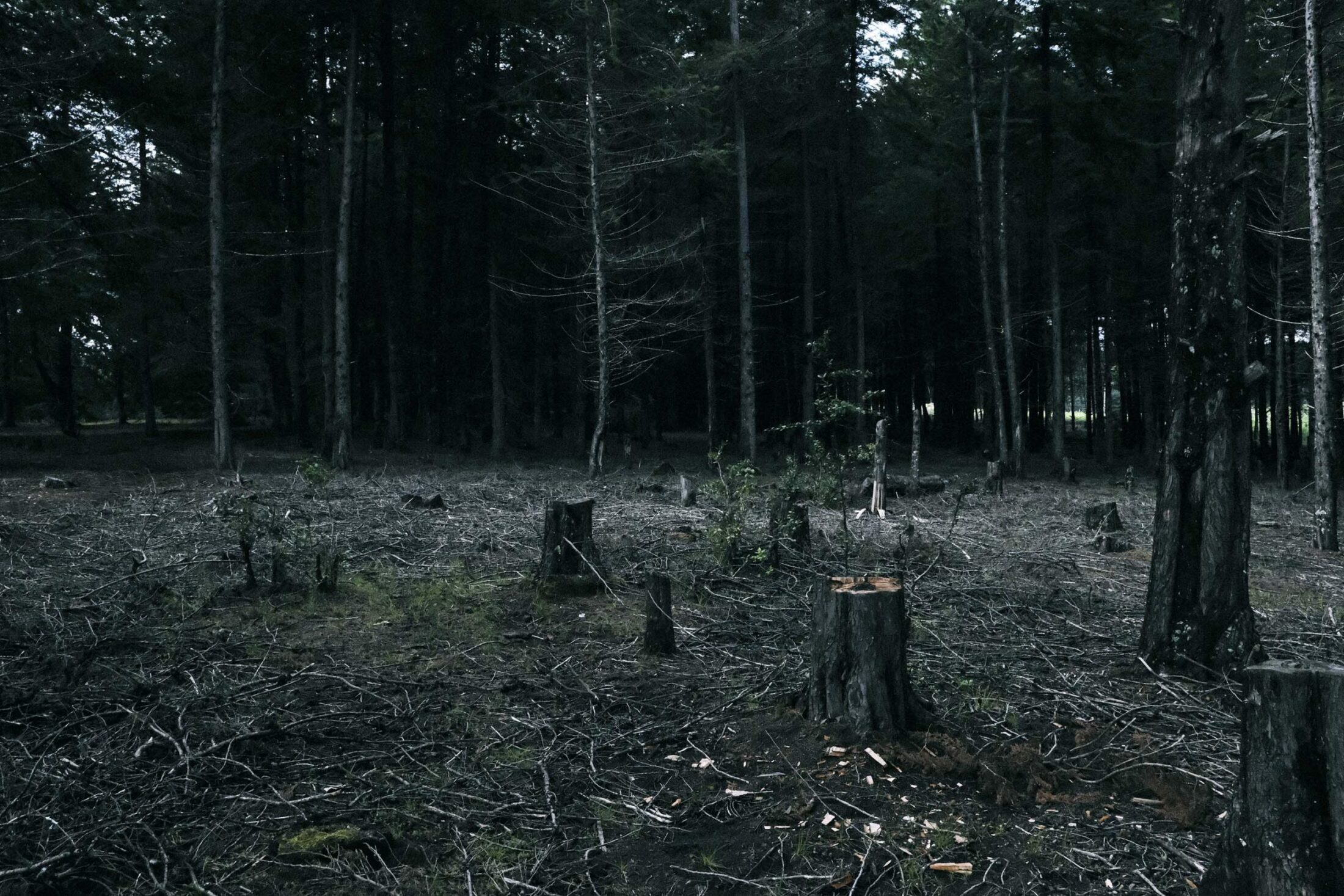
An area recently logged in the Ontulili Forest Reserve at the foot of Mount Kenya.
That forest knowledge and mountain faith persist at all is astonishing. The waning of the nineteenth century brought colonialists, Christianity, and theft to Kenya. Immense tracts of land were occupied by British settlers, leaving less space for a growing population, while colonial restrictions on the freedoms to move and work stunted livelihoods and fired resentment. Resistance took the shape of the Mau Mau uprising that began in 1952—when Thureinira was in his late twenties and Mbaya not yet born—and drew its members mostly from the Kikuyu people. The forests of Mount Kenya and the nearby Aberdares became the Mau Mau fighters’ fastness, from where they launched deadly guerrilla attacks by night against white settlers and Kenyan supporters of the regime. British colonial authorities responded to the Mau Mau’s vicious but small-scale attacks with aerial bombing raids, mass roundups, torture, and internment in prison camps instigated by Prime Minister Winston Churchill. Though Churchill led British troops against the Nazi regime, the camps built in Kenya under his administration uncomfortably echoed the concentration camps of World War II: they have been described as akin to a “gulag” by historians, and at least one camp gloried in the Auschwitz-like slogan “Labour and Freedom.”
Despite their battles and their sacrifices, Kenya’s independence was not won by the Mau Mau, but by a new political elite which, rather than dismantle the colonial system, appropriated it. Land was not returned to the Kenyan people but taken over by Kenyan leaders; the annexation and theft continued, and the oppression meted out by colonial authorities persisted under the new security forces no longer in the service of racism but elitism, directing violence against the poor and marginalized. The new rulers had no more interest in unearthing or respecting traditional belief systems than their colonial predecessors. As old ways of knowing continued to fade and the world became more crowded, the mountain’s forests were transformed into just another resource to exploit: wildlife was hunted and trees were cut down for firewood, charcoal, timber, or to make way for homesteads, agriculture, and country estates.
Rooted in Mount Kenya’s foothills, Thureinira has lived through and embodies this troubled autochthonous history. The only living things as old as him, he says with eyes narrowing and a playful smile rearranging the broad and gnarled features of his face, are the trees. And when he dies, he will be buried with them, cocooned in a cedar coffin.
Fifteen years ago, the Australian philosopher Glenn Albrecht came up with the term solastalgia to describe the feeling of distress one has when disastrous environmental change affects a landscape that means something to them. It’s a concept with ever-increasing currency as human impacts on nature become, in their ubiquity, impossible to ignore. It is the emotional state of the Anthropocene. The destruction of Mount Kenya’s forests—that narrowing of the cascade of dark green that separates the high tarns and sedge-covered moorlands from the farmlands below—means that when Thureinira’s rheumy gaze falls upon the mountain, it is both there and not there; that which remains accentuating that which is absent.
Thureinira’s bulwark against solastalgia can be found up a narrow muddy path, past the rusting carcass of an abandoned tractor and through a rickety wooden gate. Here he has laid out a dozen seed beds to create a neatly exuberant tree nursery full of knee-high indigenous saplings: cedar, yellowwood, stinkwood, and African olive. (On the same plot he also grows green bananas to eat and the legal narcotic leaf miraa to sell.) The saplings feed a program of reforestation led by the Mount Kenya Trust, a charity that works to protect the forest, conserve the mountain ecosystem, and support the lives of those living around it. Thureinira’s trees, he hopes, will be working to reclaim the land and the mountain long after his own life has ended.
Mbaya’s forest walks are a portal to a different, slower, more meaningful world.
Mount Kenya has diminished with age; gradually ground down by ice, wind, and rain, it has shrunk in stature by as much as a mile during its lifetime and has lain dormant for forty thousand years. Humanity, too, has taken its toll, locally and globally. Earth’s warming climate and lurching weather patterns mean snow caps that once blinded now shimmer uncertainly like a mirage, and the tropical glaciers are disintegrating and retreating at a pace that is anything but glacial—scientists predict these ancient torrents of ice will be gone by the end of this decade. “The mountain of brightness” is losing its luster.
Deforestation has shrunk the territory in which Mbaya walks and, during his lifetime, the distance between home and the tree line has lengthened, the forests pared and thinned by decades of illegal felling of cedar, yellowwood, olive, camphor, and rosewood.
Around the mountain, Central Kenya is a densely inhabited region of a country where the population has grown six-fold in half a century, from eight million at independence to forty-eight million today. Poverty and inequality are routine scourges—one in three people get by on just a dollar a day. In the struggle for space, forests have lost out: a little over 7 percent of Kenya remains forested (and less than 5 percent is protected), and losses of woodland run to an estimated 124,000 acres a year. Kenya has lost around ten percent of its tree cover in the last twenty years, according to Global Forest Watch.
Still, the massif dominates the equatorial landscape; its bulk sways weather patterns and its rainfall waters the nation. The Tana and Ewaso Nyrio rivers that irrigate farming land and drive hydroelectric turbines both rise on Mount Kenya, their seasonal flow regulated by the forests and moorlands. Without its forests, their rainmaking and rivers, Mount Kenya loses its mythological power and becomes just a jagged rock puncturing the horizon.
Fires, started to clear land for farming or illegal marijuana cultivation, leave their mark here too. Last year, one such fire fanned by high temperatures and strong winds tore through thousands of acres of moorland and natural bamboo forest, scarring the mountain.
Timber plantations have also done damage, excising the riotous tangle and biodiversity of indigenous forests in favor of neat lines of fast-growing, single species aliens such as eucalyptus, pine, and cypress. The threats to the forest are long-standing but they are not historical. For many in the impoverished, rural communities living around the mountain, conservation is an unaffordable luxury, and the forest a rare resource from which to extract some basic means of survival: fuel for cooking, wood to sell, land to graze or clear for a home or a field.
At the Imenti Forest—a wooded peninsula jutting into farmland on the mountain’s northeastern side, connected to the Marania Forest by a narrow spit of woodland—a ranger patrols. Haroun Mutwiri is thirty-two years old and describes his passion for trees and forests as lasting “since childhood.” The quiet of the forest here is broken by colobus monkeys sounding the alarm and heavy hornbills taking flight, their wings whumping like helicopter blades, as Mutwiri wades through grasping weeds and over loose basalt rocks to where charcoal burners recently abandoned a kiln, one of more than twenty found in this one patch of forest in previous months. Despite a government moratorium on logging since early 2018 and laws prohibiting the trade and transport of charcoal, it remains a big business and a daily need for many. Researchers from the Nairobi-headquartered World Agroforestry Centre calculate that four-fifths of Kenya’s urban households rely on cheap charcoal for cooking and that the industry employs half a million people and is worth over three hundred million dollars.
The restrictions have not stopped people from using charcoal, they have only made it more expensive, and as a result more lucrative. The unsustainable take-take from the forest—behavior antithetical to Mbaya’s actions or Thureinira’s beliefs—continues to threaten the ecosystem, which means, for Mutwiri and his colleagues, the sometimes risky cat-and-mouse pursuit of illegal charcoal burners continues.
Nor is it just humans who rely on the forest for resources, sanctuary, and life. Buffaloes and elephants, wild pigs and antelopes, monkeys, birds, and butterflies are all found here, but proximity to people inevitably brings conflict. Close to Lake Nkunga, which lies in the caldera of a collapsed volcano, is the desolation of a municipal dumpsite, a smoldering football pitch of crumbling drifts and piling dunes of stinking rubbish trucked in from the nearby town of Meru. The dump is hard on the edge of an electric fence with thick wooden posts, one of the elephant corridors designed to separate people and the wild animals, both of whom make daily pilgrimages to the lakeshore. Lovers sit together, sipping drinks in the soft late afternoon light, motorcycle taxi drivers wash their bikes in the lake water, and tinny music plays from smartphone speakers. An elephant and her calf arrive; they want to make their way to the water’s edge to drink but are put off by the noise of people. The people scurry for higher ground, laughing; the mother elephant shakes her immense head, stomps the dust and trumpets; a pair of street dogs make feinting runs at the elephants, the children accompanying them throw rocks. Later, when the people have all gone, the elephants return to drink, but the episode exposes the gulf separating modern life from wildlife. Coexistence feels an impossible dream.
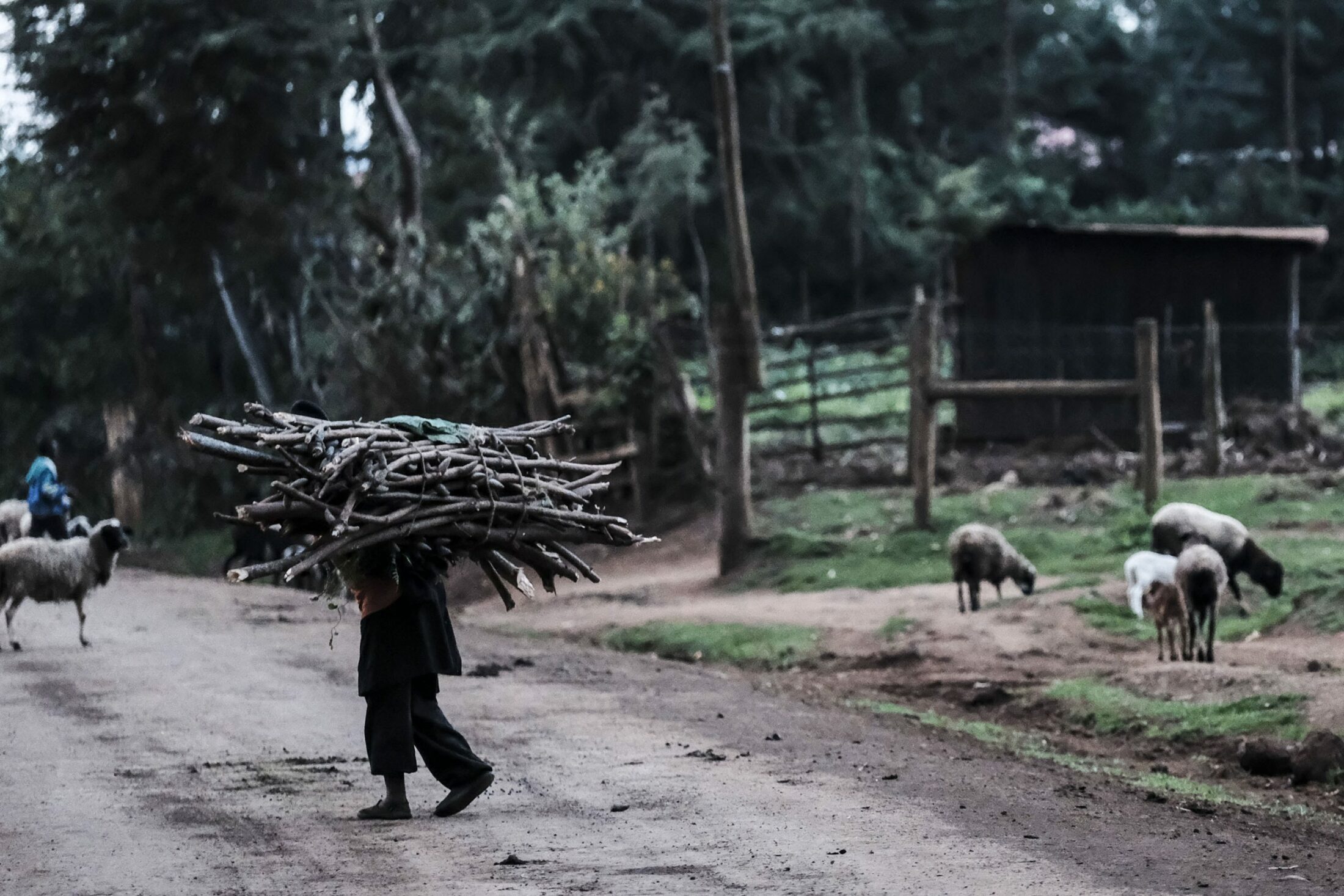
A villager carries freshly cut trees collected for firewood outside the Marania Forest.
The diminution of Kenya’s mountain forests has wide-ranging impacts, affecting rainfall patterns, river flow, erosion, and carbon sequestration. The forests are under immense human pressure, but there are others like Thureinira who also understand their value and fragility and who are also working towards their restoration.
The main highway connecting the towns of Nanyuki and Timau is asphalt, but every other is in various states of rutted and unpaved disrepair. Move away from the main road and bricks and mortar gradually give way to tin and timber. Transmission towers disappear. A steep road narrows to a muddy track, and the track leads to a tiny hillside village where I meet Catherine Karambu, a forty-year-old single mother of four, dressed in a wooly hat and diamante blouse. Cow bells chime, the sky is a scarcely believable blue, and the morning sun is bright but not yet hot. Karambu heads a fifteen-person cooperative tending to the Gatinka Tumaini tree nursery on the mountain’s northern fringe. Hosepipes snake the ground between plastic water tanks and seedbeds, while Karambu’s neighbors and colleagues ferry wheelbarrows of propagation bags about. Indigenous seeds—wild olive, black ironwood, cedar, stinkwood, and water-berry—are either donated by the Mount Kenya Trust, or collected from the forest and then grown in the nursery for six months. The trust buys back the knee-high seedlings to plant, bringing in around $600 for Karambu’s group. In addition, the growers are permitted to farm within the forest boundaries as part of a so-called “shamba system,” planting crops around the young trees that they are responsible for looking after. “It’s for the money and for conserving the forest,” says Karambu of her involvement in tree planting. “It is very financially helpful to me. I am able to keep my family well.”
Tree planting has a deep history in Kenya, where the late Nobel Peace Prize–winning conservationist Wangari Maathai established her Green Belt Movement in 1977 to reforest the nation’s degrading land. Cultivating, planting, and protecting the indigenous trees is fundamental to the gradual reconnection of the people of Mount Kenya to the landscape and a way of imagining a different, better future. To restore the forest is to restore ourselves.
As a child, Karambu would collect seeds and inch-high wildlings in the forest and bring them to her father. He prized the mugumo (strangler fig) seeds above all. “He would plant them and say, ‘These trees are for my great grandchildren,’” she recalls. She still forages now, sometimes alone and sometimes with her children. Her stride is long, sure, and fast-paced despite the high altitude and thin oxygen. We descend a denuded hillside of cypress stumps, the remnants of recently cleared plantation, and plunge into the enveloping cool and dark of the forest, the temperature abruptly dropping by forty-five degrees Fahrenheit. Karambu scans the ground as she walks, suddenly stops and deftly digs her fingers into the soil, loosening and retrieving the first shoots and roots of a new yellowwood. She looks up, briefly proud like a child winning a toy from an arcade claw machine, then drops it into a bag and continues into the forest.
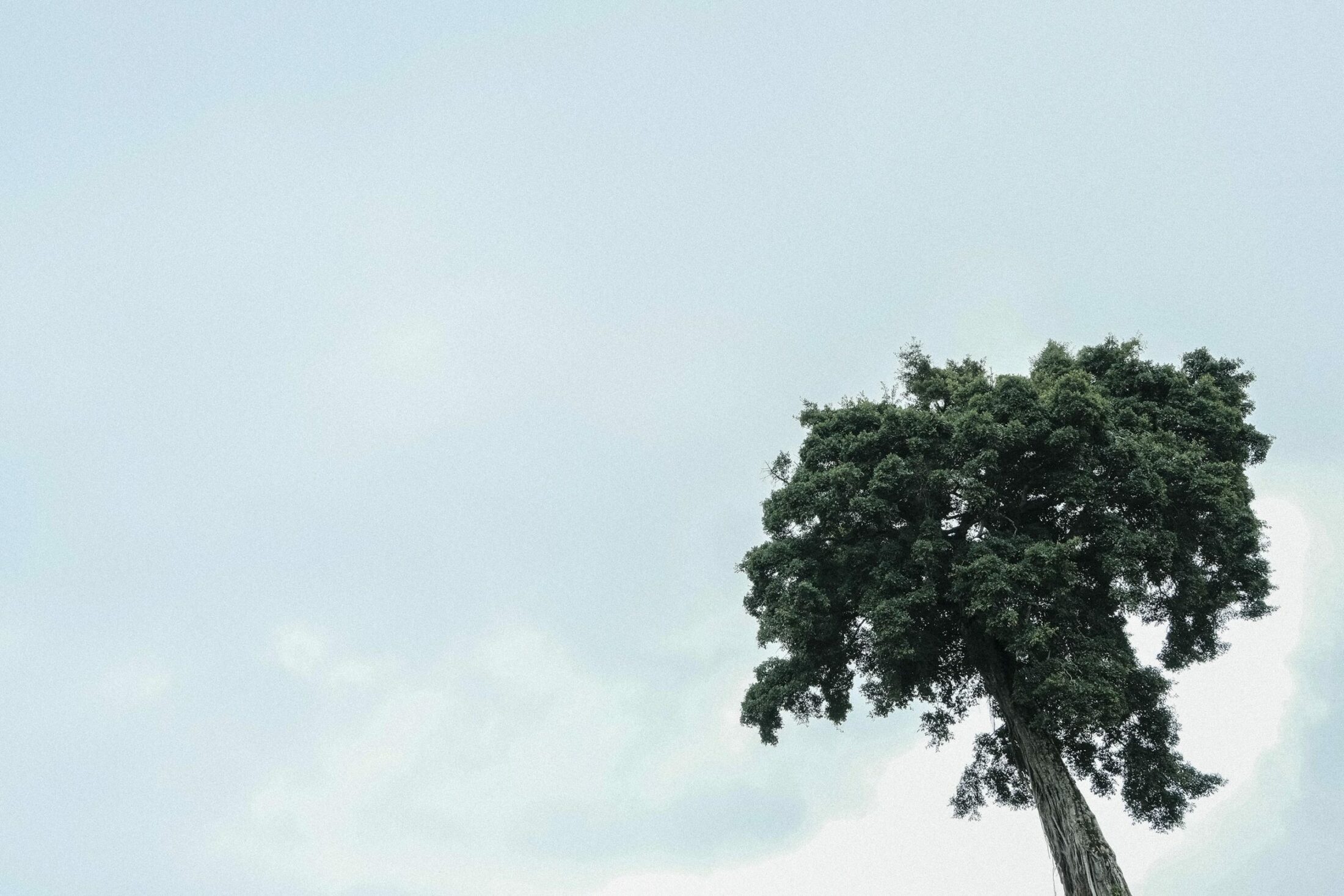
A mugumo, or strangler fig, towers above the surrounding trees.
Deep inside the fractured forests that still ring the mountain, a hallowed sense of wonder persists. One morning, soon after the sun burns mist from the mountainsides and clouds shroud the peaks, I visit part of the mountain’s few remaining areas of old-growth woodland with a pair of young Kenyan foresters from the Mount Kenya Trust. Marania Forest, on the mountain’s northern fringe, is a revelation: thickly towering trunks of eight-hundred-year-old rosewood reach overhead, the trees’ crowns held up to the light of the canopy, pencil-straight cedar and craggy-barked olive are draped with lichen, and moss carpets the earth, muffling sound to a church-like silence. It is dark, crowded, and otherworldly—the ground soft underfoot, the trunks damp to the touch, the trees centuries old, the sunlight breaking through in narrow shafts. At our feet, fallen trunks breach the understory like shipwrecks, gradually decaying and returning to the soil—to its subterranean fungal networks and the spreading roots of neighboring trees—as food for the rest of the forest. We all smile, the foresters and I. It is a routine venture out for them, and my first to these old forests, and yet our reactions are the same: joy and reverential wonder. We instinctively drop our voices to a whisper. We walk and talk, feet sinking into the damp, spongey soil as the foresters teach me about the trees.
Later that day, in a nearby section of forest, we come upon the startling sight of a pair of mugumo twisting up from either side of the path to join overhead, forming a soaring, living cathedral door. Close to this archway of boughs we find the splintered evidence of the illegal exploitation of tree felling and firewood collection. The archway itself is unscathed. It is among the parting, dangling roots of the mugumo tree that, Thureinira told me, Kikuyu men would make their sacrifices to god, seeking rain, good fortune, blessings, or protection.
Deep inside the fractured forests that still ring the mountain, a hallowed sense of wonder persists.
The practice of sacrifice beneath the mugumo is featured in Facing Mount Kenya, a 1938 monograph of Kikuyu customs written by Jomo Kenyatta, an anthropologist who studied under Bronislaw Malinowski at the London School of Economics and an African nationalist who, after being incarcerated by British authorities for six years, became the first leader of an independent Kenya. In his book, Kenyatta writes that god told the first man, Gĩkũyũ, that “whenever he was in need, he should make a sacrifice and raise his hand towards Kĩrĩ-Nyaga … and the Lord of Nature will come to his assistance.”
The mugumo holds a kaleidoscope of meanings within Kikuyu cosmology: it is a conduit between people and god, it binds humanity and nature, it manifests coexistence and connectivity, it is temple and altar, and represents power, life, and fertility. When Gĩkũyũ had nine daughters but no sons, it was at the mugumo that he offered a sacrifice and was rewarded with the appearance of nine men who became husbands to his children, and together they founded the Kikuyu clan lineages. The tree is the wellspring of the people and, like people, it cannot survive or thrive in isolation: a hemiepiphyte, the mugumo seed is laid high upon the branch of another tree, its aerial roots growing gradually downwards until they reach the soil, where its growth accelerates rapidly, strangling and outcompeting the host. The mature mugomo dominates the forest it depends upon—its trunk is multitudinous, its evergreen crown broad and luxuriantly leafed.
In his 1965 novel The River Between, Kenyan author Ngũgĩ wa Thiong’o describes a scene in which the character Waiyaki encounters the tree:
A big Mugumo tree stood near the edge of the hill. It was a huge tree, thick and mysterious. Bush grew and bowed reverently around it. And there the ancient tree stood, towering over the hill, watching, as it were, the whole country. It looked holy and awesome, dominating Waiyaki’s soul so that he felt very small and in the presence of a mighty power. This was a sacred tree.
The novel is an allegorical tale of religious colonization and, while the hegemony of Christianity has lessened the mugumo’s power, it is rarely felled out of residual respect and pragmatism, because it makes for poor firewood and bad timber. During our medicinal morning walk, Mbaya did not seek out the mugumo, but it has its place within his forest pharmacy: its boiled bark and milky sap is used to treat stomach ailments in both people and their cattle.
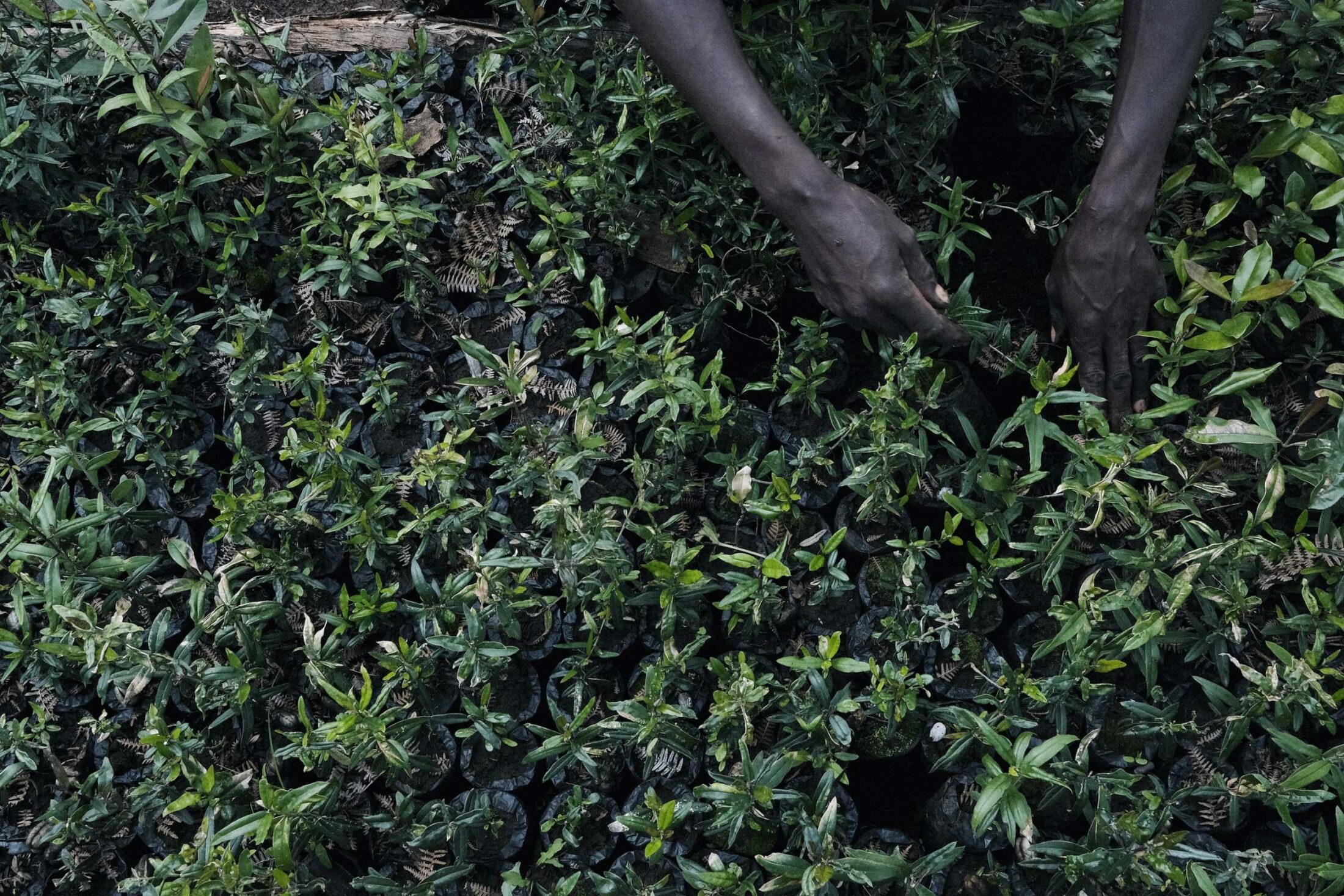
Tending seedlings at the Gatinka Tumani tree nursery in the Ontulili Forest Reserve.
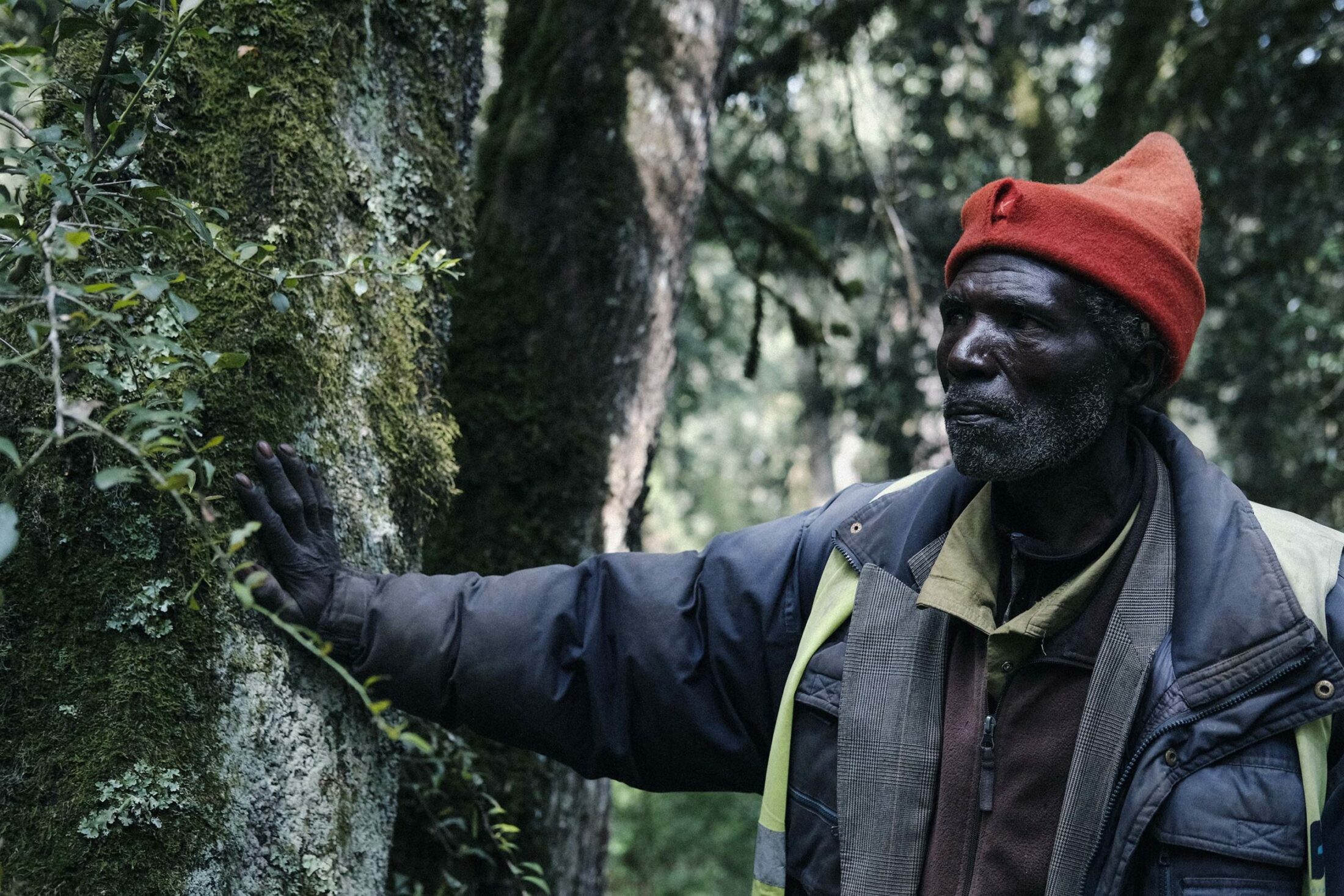
Joseph Mbaya pauses to listen to the forest, deep inside the Ontulili Forest Reserve.
Mbaya’s biweekly medicinal forays and Karambu’s quest for wildlings are proof that the forest can be used sustainably. Others enter the forest too, to collect grass or deadwood, to graze livestock, or to keep bees and harvest honey—all traditional economic activities that can exist in balance with the forest. That the forest can be used without destroying it is not news to them nor to Thureinira, but theirs is a minority view and the continued threats to the forest demand stronger efforts to protect and restore it.
Mbaya lives in Kiambogo, a village on the edge of Mount Kenya’s forest. When he is not sourcing traditional medicines and relishing in the tranquility of the forest, he is there. Over his lifetime the village has grown, but it has not moved, though it now lies further from the woods than when he was a younger man—a broad frontier of overgrazed pasture and overworked farmland separating the village from the forest. For decades people have illegally cleared the woodland, but it’s hard not to look at the denuded landscape and feel that the forest is retreating from us towards the safety of the mountain’s upper slopes. How to entice it back?
One morning, a Mount Kenya Trust truck pulls up on the muddy track that runs uphill through Kiambogo towards the forest. Its flatbed is loaded with saplings and roots swaddled in black plastic. Fifty-one-year-old farmer Magiri Munya, with an Amish beard and a ready smile, is a community leader and an old friend of Mbaya, and he oversees the day’s planting of scores of trees that will slowly help return the forest ever closer to its original reach. “For many years the forest has been cut down,” he says. “By planting these trees we are making the land as god made it.”
Munya paces out the area of farmland to be planted that day as villagers grasp saplings in their fists and wade ankle deep into the thick, dark soil. They slam hoes and shovels into the ground, gouging mud out and pressing slender saplings in. Mbaya works alongside his neighbors. As part of the shamba system, he and his fellow residents will plant potatoes and peas around the saplings, which they will harvest for a few years until the young trees are strong enough and their roots secure enough to withdraw, leaving the trees alone. With each planting, the tree line is redrawn a little further down the mountain. Munya looks out at the fresh dug field and the forest beyond. “We are restoring the forest to where it was,” he says against the thunk and chatter of the morning’s work. “I want to leave this place so that in fifty years’ time my grandchildren can see how it used to be.”
Seeing is one thing, but knowing is another. In a few days Mbaya will set off again, his movement through the trees enacting an ancient relationship with the land and the mountain, his understanding of the forest breathing life into a way of knowing and being that is misplaced, but not yet lost.
Say ye the fields may bear much fruit and the land may continue to be fertile.
Praise ye Ngai. Peace be with us.
